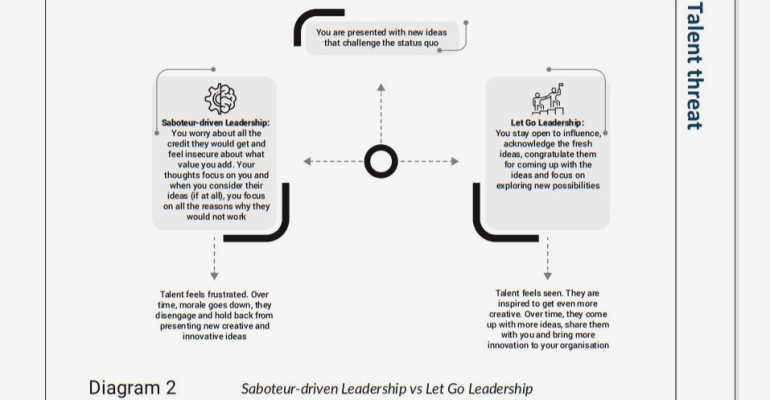The Talent Equation: How Managers, Leaders, and Culture Make or Break Succession Planning

The Talent Equation: How Managers, Leaders, and Culture Make or Break Succession Planning
It’s no secret that the war for talent has intensified. In today’s competitive landscape, skilled professionals have options, and they exercise them freely. The organisations that thrive are those that recognise that talent management isn’t just an HR function – it’s a fundamental leadership responsibility.
The Manager Effect: A Tale of Lost Potential
Take the case of a talented mid-career professional – let’s call her Sarah. Sarah was innovative, ambitious, and known for delivering results. Yet, she found herself reporting to a manager who saw her talent not as an asset, but as a threat. Rather than nurturing Sarah’s development, the manager subtly blocked her access to senior leaders, kept her from high-visibility projects, and failed to advocate for her growth.
Sarah, despite her potential, lacked the support and strategic insight to navigate these barriers. She had not been developed to influence upwards, sideways, or manage critical stakeholder relationships. Without exposure and sponsorship, her path forward became unclear. Predictably, she voted with her feet, leaving for an organisation that recognised her value.
The Manager’s Role in Talent Flight
Sarah’s case is not an anomaly. When managers hoard talent instead of cultivating it, organisations haemorrhage their best people. This is especially true when systems and processes fail to ensure consistency, accountability, and governance.
If a talented individual isn’t equipped with the skills to manoeuvre within these systems, they’ll seek environments where they can thrive.
This is why we work with both future talents and experienced leaders including HR – because succession planning isn’t just about identifying talent; it’s about ensuring that talent is nurtured and empowered.
Leaders: Architects of Culture or Roadblocks to Growth?
Beyond managers, leaders set the tone. If a leader fails to share their vision and create a culture that inspires followership, they inadvertently contribute to talent stagnation. Worse, if leaders themselves exhibit the same behaviours as the blocking manager – hoarding decision-making, limiting opportunities, or failing to empower their teams – then organisations lose their best people at all levels. I share many examples and case studies in my book, Let Go Leadership.
Great leaders understand that talent development isn’t a tick-box exercise; it’s a continuous commitment to building cultures of shared power, growth, and inclusivity. They don’t just manage succession planning; they embody it. That’s why our Leader as Coach programmes embed the skills required to lead inclusively, ensuring that teams don’t just perform, but thrive.
Culture: The Invisible Hand Guiding Talent Retention
No single manager or leader can solve this alone. Without a culture that actively nurtures diverse talent, succession plans remain theoretical.
Culture isn’t just about intention – it’s about infrastructure.
- HR must champion structures that support talent growth, from sponsorship programs to performance systems that reward development, not just output.
- Leaders must role-model inclusivity, making talent development a key metric of leadership success.
- Managers must be trained to create environments where diverse talent can thrive – not just those who fit a predefined mold.
- Talent must be developed to navigate complexity, build networks, and proactively manage career paths.
When these elements are in place, talent doesn’t just stay – it grows, drives innovation, and builds long-term organizational success.
The Subtle Art of Building Future Talent
We’ve spent years refining our approach to talent development, leadership coaching, and cultural transformation. As leaders and shaperts of culture, we should not simply “fix” individuals; we must all reshape ecosystems. Organisations that get this right don’t just retain talent – they cultivate future leaders who carry their vision forward. They effectively succession plan!
Because in the end, the best talent strategy isn’t about retention – it’s about engagement, empowerment, and evolution.
The question isn’t whether your organisation has talent. The question is: Are you making the most of it?
How Do You Make the Most of Talent?
Talent thrives when organisations focus on three critical areas:
- Self-leadership: Ensuring individuals at all levels develop the agency skills to own their career trajectory – ideally within your organisation by effectively managing stakeholder relationships, influencing, and navigating power structures.
- Constructive Conversations: Shaping a strong feedback culture that equips everyone to speak up without damaging relationships; one that also equips managers and leaders with the ability to engage in honest, developmental dialogue that unlocks & retains potential.
- Leader as Coach: Training leaders to support, stretch, and empower their teams rather than micromanage or block them.
Most talent isn’t lost due to a lack of ambition or ability – it’s lost to environments that fail to harness and elevate it.
The question for every organisation is:
Are we creating the conditions where talent can thrive, or are we quietly pushing our best people out the door?












